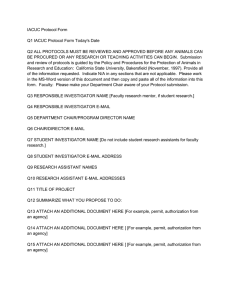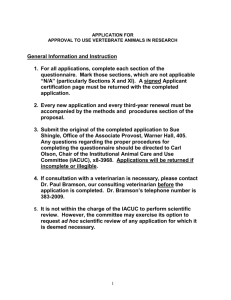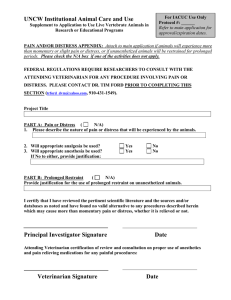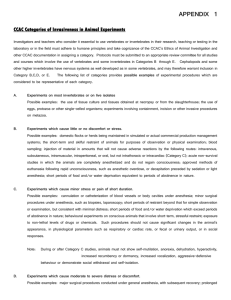IACUC Protocol Review Form
advertisement
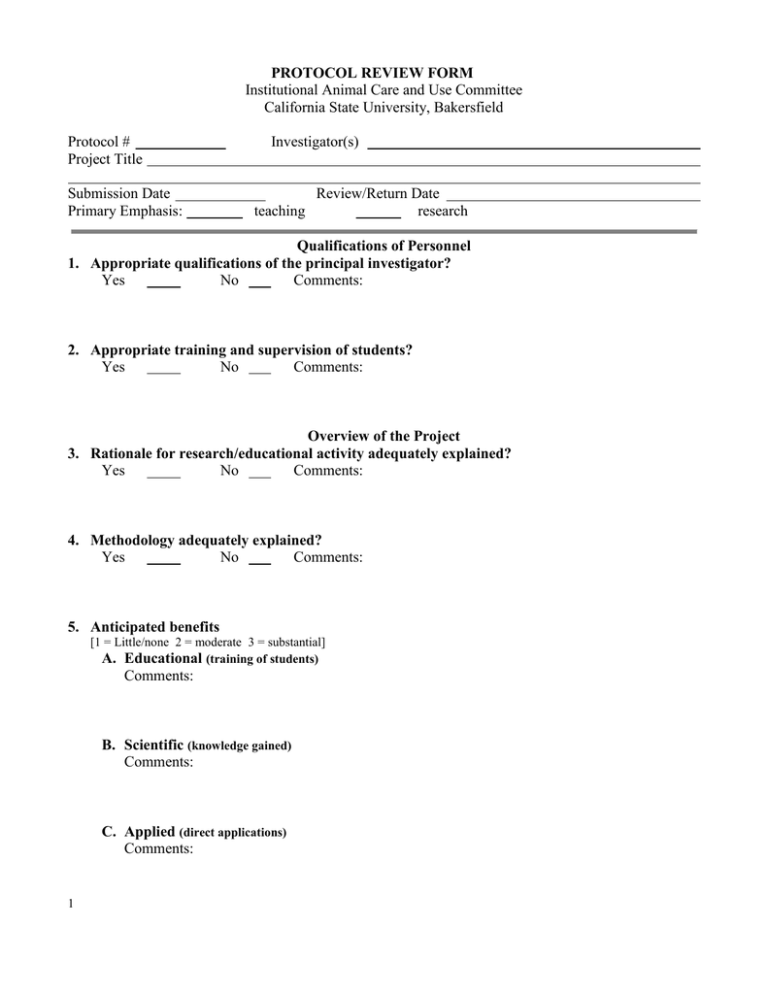
PROTOCOL REVIEW FORM Institutional Animal Care and Use Committee California State University, Bakersfield Protocol # Project Title Submission Date Primary Emphasis: Investigator(s) Review/Return Date teaching research Qualifications of Personnel 1. Appropriate qualifications of the principal investigator? Yes No Comments: 2. Appropriate training and supervision of students? Yes No Comments: Overview of the Project 3. Rationale for research/educational activity adequately explained? Yes No Comments: 4. Methodology adequately explained? Yes No Comments: 5. Anticipated benefits [1 = Little/none 2 = moderate 3 = substantial] A. Educational (training of students) Comments: B. Scientific (knowledge gained) Comments: C. Applied (direct applications) Comments: 1 Justification for Use of Animals 6. Justification of the species selected: Yes No Comments: 7. Consideration of alternatives not using animals: Yes No Comments: 8. Minimization of the number of animals: Yes No Comments: 9. No unnecessary duplication of previous efforts: Yes No Comments: Specifics of Animal Involvement (Requested information is provided) 10. 11. 12. Species Information Yes No Comments: Restrictions? Yes Comments: No If Surgical Procedures, then: a. Aseptic techniques Yes No Comments: b. Anesthesia and monitoring Yes No Comments: c. Post-operative care Yes No 2 Comments: 13. Pain/Discomfort Yes No Comments: 14. Requires No Elimination of Pain/Discomfort? Yes No Comments: 15. Animal/Human Hazardous Materials Exposure? Yes No Comments: 16. Disposition of Animals Following the Project a. Disposition of Animals (what will happen to them?): Yes No Comments: b. Euthanasia Consistent with USDA Regulations: Yes No Comments: c. Disposition of Animals Following Euthanasia: Yes No Comments: Care and Housing of Animals (Requested information is provided) 17. Housing Provisions Yes No Comments: 18. Who Cares for the Animals? Yes No Comments: 19. Provision of Medical Care? 3 Yes No Comments: 20. Provisions for Emergency Notification? Yes No Comments: 21. Care/Housing Consistent with PHS and USDA Regulations? Yes No Comments: Section A Investigator Rating Section B Investigator Rating None Anticipated Pain and Distress Evaluator Rating Evaluator Rating Comments: Comments: Any Deviations from Requirements? Written justification Comments: "Anticipated Benefits" vs. "Anticipated Pain and Distress" Provide a global assessment of the project based on your evaluation of the "Anticipated Benefits" vs. the "Anticipated Pain and Distress." Costs to animals are minimal; potential benefits outweigh costs. Costs to animals are moderate; potential benefits outweigh costs. Costs to animals are severe; potential benefits outweigh costs. Costs to animals are minimal; potential benefits do not outweigh costs. Costs to animals are moderate; potential benefits do not outweigh costs. Costs to animals are severe; potential benefits do not outweigh costs. 4 Recommended Action Unconditional Approval Disapproval Conditional Approval (with specified changes) Other (indicate) Changes: Comments: Date 5 Reviewer Signature Anticipated Pain and Distress [Please rate the protocol in both sections A and B.] A. Adapted from Orlans (1990) & Shapiro & Field (1987) 1. Protocols involving either no living materials, live isolates, or most invertebrate species. Examples: the use of tissue culture and tissues obtained at necropsy or from the slaughterhouse; the use of eggs, protozoa, or other single-celled organisms; use of invertebrate species with a simple nervous system. 2. Protocols with vertebrate species in their natural setting. Examples: passive observations of vertebrates in their natural setting; manipulations in the natural setting involving no food, or water deprivation, noxious stimulation, or restraint. 3. Protocols that cause little pain or stress to vertebrate species. Examples: protocols involving invertebrates with complex nervous systems; vertebrate studies involving the short-term and skillful restraint of animals for purpose of observations or physical examination; injection of non-toxic material by the following routes: intravenous, subcutaneous, intramuscular, intraperitoneal, or oral; acute non-survival studies in which the animals are completely anaesthetized and do not regain consciousness; approved methods of euthanasia following rapid unconsciousness; short periods of food and/or water deprivation equivalent to periods of abstinence in nature. 4. Protocols that cause moderate pain or stress to vertebrate species. Examples: vertebrate studies involving cannulation or catheterization of blood vessels or body cavities under anesthesia; minor surgical procedures under anesthesia, such as biopsies, paratoscopy; short periods of restraint beyond that for simple observation or examination, but consistent with minimal distress; short periods of food and/or water deprivation which exceed periods of abstinence in nature; behavioral protocols on conscious animals that involve short-term, stressful restraint; use of noxious stimuli from which escape is possible. 5. Protocols that cause significant stress or pain to vertebrate animal species. Examples: vertebrate studies involving major surgical procedures conducted under general anesthesia with subsequent recovery; induction of anatomical or physiological abnormalities that will result in pain or distress; application of noxious stimuli from which escape is impossible; prolonged (several hours or more) periods of physical restraint; induction of behavioral stresses such as maternal deprivation, aggression, predator-prey interactions; procedures which cause severe, persistent, or irreversible disruption of sensorimotor organization. 6. Protocols that cause severe pain near, at, or above the pain tolerance threshold of unanesthetized conscious animals. Examples: use of muscle relaxants or paralytic drugs for surgical restraint without the use of anesthetics; severe burn or trauma infliction on unanesthetized animals; toxicity testing and experimentally-induced infectious disease or other induced conditions that have death as the endpoint; attempts to induce psychotic-like behavior; killing methods not USDA approved; inescapably severe stress or terminal stress. 6 B. USDA Pain Classification Potential Level of Pain None or minor Significant Significant 7 Pain Relief None Given None Pain Perceived None or minor None to intolerable Tolerable to intolerable
